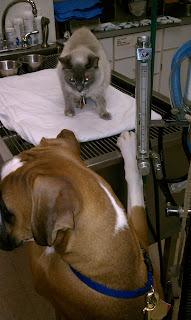Pet's lives are divided into 4 groups: Pediatric (0-1 years), Adult (1-6 years), Senior (7-10 years) and Geriatric (10+ years). It is during the Adult to Senior transition that age related diseases begin to show and us, as veterinarians, need to be doing our best to diagnose them and start treatment. In general, cats live longer than dogs, small dogs live longer than large dogs. See the Human/Pet Age Analogy chart below:

Aging is not a disease but a complex process influenced by genetics, environment, stress and nutrition. Genetics are responsible for 30-35% of the aging process, and it is something we have little control over. Environment, stress and nutrition are all areas that we directly influence and have the ability to improve for our pets. Preventative medicine is the best way to diagnose early signs of a disease process beginning and includes regular physical exams as well as routine screening blood-work and urinalysis reports. Good nutrition with a diet high in anti-oxidants and regular exercise are very beneficial. Several studies have shown that 2, 10 minute daily walks can increase a patient's mental attitude by increasing oxygen to the brain and increasing chemical levels in the brain. When considering an anti-oxidant to give your pet, please consult your veterinarian for advice. As a general rule, all supplements should contain a lot # and expiration date.
Changes associated with aging include:
1. Dryness of tissues including decreased tear production and less saliva in the mouth
2. Steady decrease in organ function
3. Decreased oxygen to tissues throughout the body
4. Changes in the way cells function
5. Decreased immune competence
6. Personality alterations including increased irritability or confusion
Some specific things you need to know about your older pet:
1. Geriatric animals are not as effective at thermoregulation. This means they develop cold intolerance during the winter months or heat intolerance in the summer. As our pets get older, they have a decreased ability to pant which, in the end, can lead to heat stroke. Pets that respond to "cool ambient temperatures" may have difficulty sleeping, do not want to go outside and may tremble for no known reason.
2. Loss of muscle mass and function is inherent to aging. Older pets often have hind limb weakness or lameness as a result of the changes in the number of muscle cells as well as chronic changes in these cells. Low protein diets can also severely decrease the amount of muscle mass overtime. Diets high in essential amino acids and a regular exercise program are important for preventing pre-mature muscle loss.
3. Inappetence or a "picky eater" is not an uncommon complaint with geriatric pets. As they age, the sense of smell and ability to taste decrease by 25% and less saliva is produced. These changes combined with muscle atrophy of the muscles used during chewing may make some pets reluctant to eat dry, hard foods. Also, dry foods are not as aromatic as wet foods and so they may become less appetizing over time. Heating canned food to a warm temperature and transiting foods over a longer period can be very helpful when dealing with geriatric cats or dogs.
4. As with people, dogs and cats skin and coats change with age. There is a decrease of hair pigment and dryness of the skin and coat over time. Working with your veterinarian to find a bathing routine to moisturize and add oils to the skin can be very helpful when managing their coats. Older pets may also develop hyperkeratosis (crusting of the nose of paw pads) and lentigo (freckles in cat's mouths) over time.
5. Chronic Renal Failure (CRF) is a common disease in dogs and cats. The functional unit of the kidney is the nephron. Overtime, there is a steady loss of nephrons which leads to the progression of renal disease. Early detection of nephron loss is possible by doing routine blood-work and urinalysis screenings and can pick up changes before your pet begins to show you signs at home.
6. Hearing loss occurs in older pets as it does in people. In one study, 48% of dogs over 12 years of age had significant hearing deficits. By 16 years of age, 97% had significant hearing deficits including total dearness. A vibrating collar may be an option for your older pet to help get their attention. During early hearing loss, a high-frequency whistle may be another option.
7. There are chronic changes that occur in the eyes of pets. Cloudy eyes caused by normal aging of the lens (Lenticular Sclerosis) is different from cataracts which are dense changes in the lens. All pets with ocular changes should be evaluated by a veterinarian.
8. Liver decline chronic valvular disease and pulmonary decline are also all progressive diseases which develop over time. Regular exams by a veterinarian can help identify these early and lead to the best treatment and preventative choices.
9. The immune system of geriatric pets gradually deteriorates . This is a major factor to the increased frequency of morbidity and mortality among older pets. Dietary vitamin E and beta carotene can boost the immune system and are often incorporated into premium "senior" diets.
Behavioral changes in pets as they age may be attributed to specific brain diseases such as Cognitive Dysfunction Syndrome. Owners often notice the pets cannot sleep through the night, they become restless or move from spot to spot. Other signs of CDS include inappropriate urination/defecation, increased vocalization, reclusiveness, disorientation/confusion or excessive grooming. It is important to discuss these changes with your veterinarian when they are first noticed. There are several medical therapy options that can significantly improve the quality of life of your pet suffering from CDS. Therapies include prescription diets (The Brain Diet from Hills), anti-oxidants, prescription medications and exercise.
I recommend semi-annual physical exams for all pets over 6 years of age and annual wellness screens including blood-work and an urinalysis report. These 3 things are crucial for early detection and treatment of diseases associated with aging. Speak to your veterinarian today about your geriatric cat or dog.
(This post was adapted from a Continuing Education lecture given by Dr. William Fortney from Kansas State University)















